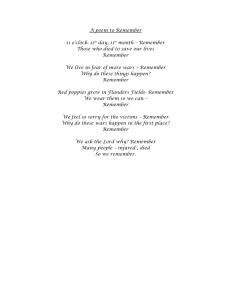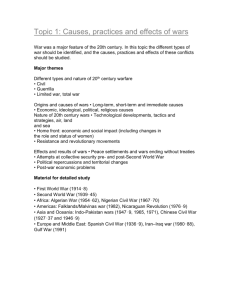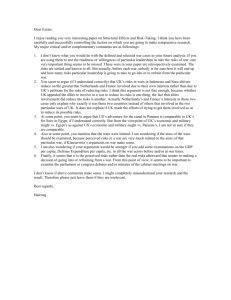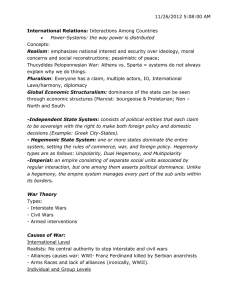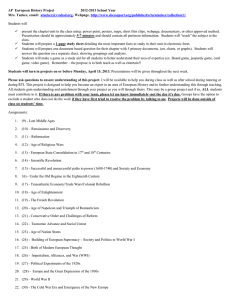The ecology o f benthopela gic ... an integrated m anagem ent approach
advertisement
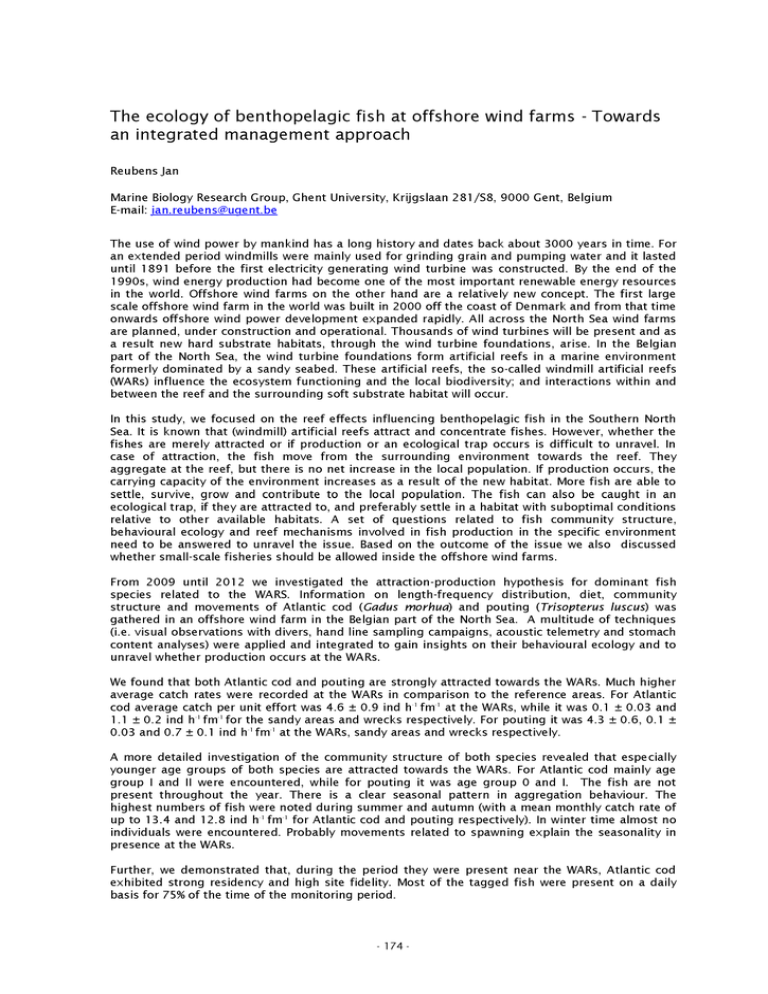
The ecology o f benthopelagic fish at offshore wind farm s - Towards an integrated m anagem ent approach Reubens Jan Marine Biology Research Group, Ghent University, Krijgslaan 281/S8, 9000 Gent, Belgium E-mail: ian.reubens@ uqent.be The use o f wind power by m ankind has a long h istory and dates back about 3000 years in tim e. For an extended period w ind m ills were m ainly used fo r g rind ing grain and pum ping w ater and it lasted until 1891 before the firs t e le ctricity generating wind tu rb ine was constructed. By the end o f the 1990s, w ind energy production had become one o f the m ost im p o rta n t renewable energy resources in the w orld. O ffshore wind farm s on the o the r hand are a relatively new concept. The firs t large scale offshore wind farm in the w orld was b u ilt in 2000 o ff the coast o f Denmark and from th a t tim e onwards offshore w ind power developm ent expanded rapidly. A ll across the N orth Sea wind farm s are planned, under construction and operational. Thousands o f w ind tu rb ine s w ill be present and as a result new hard substrate habitats, th ro u g h the w ind tu rb ine foun da tio ns, arise. In the Belgian part o f the North Sea, the w ind tu rb ine fo un da tio ns fo rm a rtificia l reefs in a marine environm ent fo rm e rly dom inated by a sandy seabed. These a rtific ia l reefs, the so-called w in d m ill a rtificia l reefs (WARs) influence the ecosystem fu n ctio n in g and the local biodiversity; and interactions w ith in and between the reef and the surrounding so ft substrate habitat w ill occur. In th is study, we focused on the reef effects influencing benthopelagic fish in the Southern North Sea. It is known th a t (w indm ill) a rtificia l reefs a ttract and concentrate fishes. However, w hether the fishes are m erely attracted or if production or an ecological tra p occurs is d iffic u lt to unravel. In case o f attraction, the fish move from the surrounding environm ent tow ards the reef. They aggregate at the reef, but there is no net increase in the local population. If production occurs, the carrying capacity o f the environm ent increases as a result o f the new habitat. More fish are able to settle, survive, grow and co ntribu te to the local population. The fish can also be caught in an ecological trap, if th ey are attracted to, and preferably settle in a habitat w ith suboptim al conditions relative to o the r available habitats. A set o f questions related to fish co m m un ity structure, behavioural ecology and reef mechanisms involved in fish production in the specific environm ent need to be answered to unravel the issue. Based on the outcom e o f the issue we also discussed w hether small-scale fisheries should be allowed inside the offshore wind farm s. From 2009 u ntil 2012 we investigated the a ttractio n-pro du ction hypothesis fo r d om in a nt fish species related to the WARS. Inform ation on length-frequency d is trib u tio n , diet, co m m un ity structure and m ovements o f A tla n tic cod (Cadus m orhua) and pouting ( Trisopterus luscus) was gathered in an offshore w ind farm in the Belgian part o f the North Sea. A m ultitu de o f techniques (i.e. visual observations w ith divers, hand line sam pling campaigns, acoustic te lem etry and stomach content analyses) were applied and integrated to gain insights on th e ir behavioural ecology and to unravel w hether production occurs at the WARs. We found th a t both A tla n tic cod and p outing are stron gly attracted tow ards the WARs. Much higher average catch rates were recorded at the WARs in com parison to the reference areas. For A tla ntic cod average catch per unit e ffo rt was 4.6 ± 0.9 ind h 1f m 1 at the WARs, w hile it was 0.1 ± 0.03 and 1.1 ± 0.2 ind h 1f m 1fo r the sandy areas and wrecks respectively. For pouting it was 4.3 ± 0.6, 0.1 ± 0.03 and 0.7 ± 0.1 ind h 1f m 1 at the WARs, sandy areas and wrecks respectively. A more detailed investigation o f the co m m un ity structure o f both species revealed th a t especially younger age groups o f both species are attracted tow ards the WARs. For A tla n tic cod m ainly age group I and II were encountered, w hile fo r pouting it was age group 0 and I. The fish are not present th ro u g h o u t the year. There is a clear seasonal pattern in aggregation behaviour. The highest num bers o f fish were noted during sum m er and autum n (with a mean m on thly catch rate o f up to 13.4 and 12.8 ind h ' f m 1 fo r A tla n tic cod and pouting respectively). In w in te r tim e alm ost no individuals were encountered. Probably m ovements related to spawning explain the seasonality in presence at the WARs. Further, we dem onstrated that, during the period they were present near the WARs, A tla n tic cod e xhibited strong residency and high site fid e lity. Most o f the tagged fish were present on a daily basis fo r 75% o f the tim e o f the m on itoring period. - 174 - Stomach content analyses revealed th a t both A tla n tic cod and pouting fed on the epifaunal species present at the WARs. The d om in a nt prey species in the d ie t o f pouting were Jassa herdm ani, Pisidia longicornis, Pisces sp. and Liocarcinus spp. In the d ie t o f A tla n tic cod J. herdm ani, P. longicornis, Liocarcinus spp., Necora puber, and Pisces sp. were m ost dom inant. Some am phipod species (i.e. Phtisica m a rin a and M onocorophium acherusicum ) had a high frequency o f occurrence as well and reached high abundances, but co ntribu te d less to the to ta l prey biomass fo r both species. The p redom inant prey species in the d ie t were all present in high densities at the WARs. To acquire more inform a tion on the q ua lity o f the food, energy p ro filin g o f both fish species was perform ed. The fishes had more energy available than required to m aintain th e ir m etabolism . Thus, enough energy was left fo r grow th and reproduction. As a result the WARs are considered a suitable feeding ground w ith sufficient, good q u a lity food available. In addition, the fitness o f pouting and A tla n tic cod was com pared between the WARs and the reference areas. No sign ifican t differences in fitness were found, indicating the WARs are not in fe rio r in q u a lity to the reference habitats. Based on the integrated results it was concluded th a t production occurs on a local scale (i.e. at the WARs). However, so fa r no changes in p ro d u ctiv ity were observed on a regional scale. The results obtained during th is study allowed to describe the life -h is to ry o f A tla n tic cod and pouting at the WARs. The age group I A tla n tic cod arrive at the WARs in April-M ay. They feed on the epifaunal prey species present, grow and stay in the area u n til the end o f the year. By w in te r m ost Igroup individuals have left the WARs and only few specimens come back after the spawning period. For pouting the O-group arrives at the WARs in September and feeds on the epifaunal prey species. They leave the area by January but by May the l-group is back at the WARS and stay again u ntil the end o f the year. D uring th is period feeding and grow th are observed. The offshore wind farm s in the Belgian part o f the North Sea are closed to fisheries. However, pressure groups aim ing at the fa c ilita tio n o f passive fisheries inside the wind farm concession areas, are active in Belgium. Based on the current knowledge on the ecology and population structuring o f A tla n tic cod and pouting at the WARs, we conclude th a t no fisheries activities should be allowed inside the offshore wind farm s in the Belgian part o f the North Sea. We su pp ort this statem ent w ith several argum ents: 1) no indication o f regional production was observed yet; 2) juvenile fish dom inated the catches; 3) there is a seasonal pattern in presence and 4) fisheries exclusion areas w ill benefit both fish populations and fisheries. In conclusion, we dem onstrated th a t WARS influence the behavioural ecology o f A tla n tic cod and pouting. They benefit from these a rtific ia l hard substrates and thrive well in th is environm ent closed to fisheries. We su pp ort th is fisheries closure, because the benefits are exported beyond the boundaries o f the wind farm concession since the fish leave the protective area once th ey grow older. Proper management, th ro u g h w e ll-th o u g h t-o u t marine spatial planning and regulations, should be im plem ented to reduce conflicts and use the marine resources in a sustainable way. - 175 -

